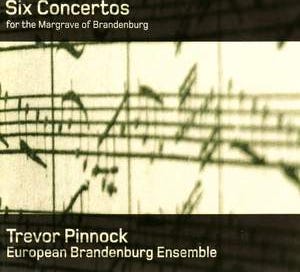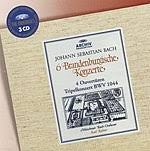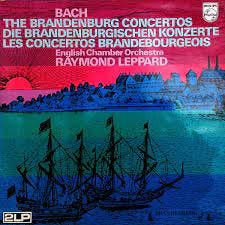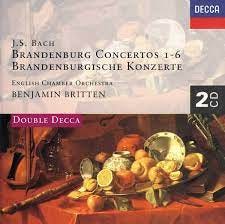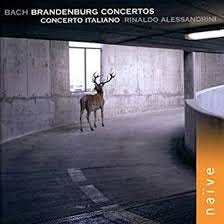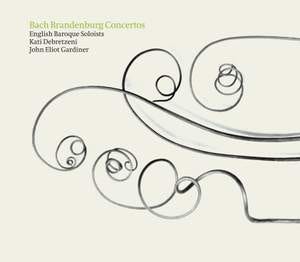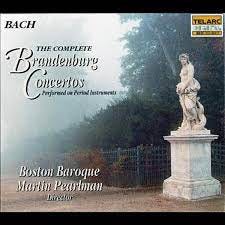“Bach is the beginning and end of all music”
-Composer Max Reger
Entry #21 on the list of the top 50 classical recordings of all-time is a 2007 recording of Johann Sebastian Bach’s The Brandenburg Concertos 1-6 (Complete) performed by the European Brandenburg Ensemble led by Trevor Pinnock on the AVIE record label.
The Composer
If you have been a regular reader of this newsletter, you may remember we included a Bach recording for #8 on the list, the Goldberg Variations as played by Glenn Gould.
Johann Sebastian Bach (b. 1685 – d. 1750), considered by many to be THE greatest composer of all time, was a German composer of the baroque era. In his day, Bach was known more for being an organist than a composer. But Bach was extremely innovative and pioneering in his compositions, especially in his use of counterpoint (in music, counterpoint is how two or more musical lines interact when they are harmonically dependent on each other, but independent in melody and rhythm). The structure, logic, and complexity in Bach’s music reflect the rigor and ethic of his work. Bach wrote Masses, motets, cantatas, concertos, religious and sacred music, organ works, sinfonias, and sonatas for individual and mixed instruments. He was a prodigious composer, and although Bach’s music fell out of favor and out of use for many, many years, thank goodness his genius was recognized once again particularly in the twentieth century.
Bach was, and is, revered as a composer. Beethoven once said, “He should be called not Bach [‘brook’] but Mer [‘sea’] on account of his endlessly inexhaustible wealth of musical ideas.” Famous opera composer Rossini said of Bach, “If Beethoven is a prodigy of man, Bach is a miracle of God.” Finally, Brahms is quoted as saying, “Study Bach. There you will find everything.”
In the pantheon of Bach’s compositions are included such masterpieces as The Goldberg Variations, The Well-Tempered Clavier, The Cello Suites, Sonatas and Partitas for Solo Violin, The Brandenburg Concertos, The Violin Concertos, Keyboard Concertos, Mass in B Minor, and the St. Matthew Passion to only scratch the surface.
The Brandenburg Concertos
If I had to choose only one piece of music to take with me to the proverbial desert island, it would be Bach’s Brandenburg Concertos. I first fell in love with these works some 31 years ago when I purchased a recording of the Brandenburg Concertos 4-6 at a tiny music shop in Assisi, Italy. It was by the English Chamber Orchestra conducted by Raymond Leppard, a recording I still cherish. When I feel depressed, I listen to the Brandenburg Concertos. When I feel happy, I listen to the Brandenburg Concertos. They never fail to make me appreciate life itself with the joy music brings, and the genius of Bach. These pieces are sunny and happy.
In the liner notes from Gustav Leonhardt’s groundbreaking set from the 1970s, Jay Balenkof writes:
“Why – many have wondered – are they called Brandenburg Concertos? Was Brandenburg an instrument, a musician, a patron, a palace, a city for which Johann Sebastian Bach wrote them? The answer is, none of the above. Bach began these “concertos with various instruments” around 1718, designing them for his musicians at Prince Leopold’s Cothen court. By the time he finished the scores in 1721, however, he had tired of Cothen, and on March 24 he sent copies of the concertos to Christian Ludwig, Margrave of Brandenburg, apparently hoping for a post at the Brandenburg court in Berlin. Alas, no job with the margrave materialized, and it is uncertain whether the Brandenburg orchestra ever played Bach’s concertos: the group was a small one and could not have managed the first four concertos at all without bringing in musicians from elsewhere.”
In any case, the Brandenburg name was applied to the group of concertos in 1873 by Bach’s biographer Philip Spitta. The concertos Bach had sent the margrave were stunning in their mastery of writing for different instruments, and in their sophistication and complexity. Each concerto is unique, following a grand plan Bach had for showcasing different sets of instruments. Bach highlighted specific solo instruments, while at the same time employing a small chamber ensemble for the accompaniment to create concertos. Bach did not invent the concerto, but rather elevated it to an entirely greater dimension.
Lester Trimble gives excellent descriptions of each concerto from the notes included in the classic set from Pablo Casals and the Marlboro Festival Orchestra:
Concerto No. 1 in F major – two horns, three oboes, bassoon, and violin
“The First Concerto differs from the other five in two important respects: it contains a fourth movement, not normally found in concerto grosso form, and its concertino is considerably larger than those of the other Concertos. By employing a force of seven soloists, Bach was able to achieve a degree of instrumental elaborateness and intricacy that far outstrips the usual concerto grosso, approaching at times the sound of a suite for full orchestra”
Concerto No. 2 in F major – trumpet, flute (recorder), oboe, violin
“All four instruments in the concertino of the Second Concerto are in the high register, with two of them (trumpet and oboe) having the brilliant “edgy” sound which is one of the most endearing qualities of Baroque music. It is, partially, because of the sound of the high trumpet part, difficult in Bach’s time on the valveless trumpet, and almost impossible on a modern instrument, that this Concerto has been a favorite with present-day listeners. But the undulating phrases of the Andante are among the most ravishingly beautiful creations in Western music. They, too, have much to do with the Concerto’s profound appeal.”
Concerto No. 3 in G major
“For reasons which seem not to be entirely understood, Bach did not provide a slow movement for the Third Concerto. Instead, he simply separated the two fast movements by a pair of cadential chords, a kind of musical shorthand to represent the slow movement that normally would have been in that position. The music is scored in nine parts – three violins, three violas, and three cellos – plus continuo. In solo passages, the instruments remain most frequently within their discrete groupings.”
Concerto No. 4 in G major – violin, two flutes (recorders)
“The Fourth Concerto has a mood of elevation and intensity not paralleled elsewhere in the Brandenburgs. Although three instruments are employed, it features the violin in a solo role, especially in the first movement. Indeed, so prominent and virtuosic is this violin part that it is hardly surprising that Bach was later to transcribe this work as a solo concerto, albeit for harpsichord – rather than violin – and orchestra. The cadenza-like passages in the third movement, consisting of rapid scale passages and double-stops, are among the most electrifying in any instrumental display piece.”
Concerto No. 5 in D major – flute, violin, piano (harpsichord)
“The Fifth Concerto is the only one of the group to employ a keyboard instrument as a soloist, and its part is charged with passages of such demonic intensity that they rival, for sheer hair-raising force, the violin cadenzas in the Fourth Concerto. The slow movement is an elegant trio for the unaccompanied soloists and the last movement a buoyant Gigue.”
Concerto No. 6 in B-flat major – two violas, cello
“The Sixth Concerto, for strings, omits violins from its instrumentation, thus insuring a prevailing dark coloration, pierced by the violas with their somewhat “reedy” high tones. In the Adagio, the accompanying instruments fall silent. The concertino, at times vaguely differentiated from the rest of the strings, is allowed to sing forth in poignant solitude. The final Allegro is a busy, syncopated movement, in the style of a Gigue.”
There is no evidence that Bach intended the six concertos to be performed as a set, one after another. Nevertheless, they make a wonderful impact when heard together, especially since none of them are particularly long concertos. In modern times, the concertos have been played as large orchestral pieces with several to a part in the strings; they have also been played more as chamber pieces with a single instrument to a part which has been more typical of groups using a more historically informed approach and practice. The concertos have also been arranged for a four-hand piano duet by composer Max Reger.
In short, The Brandenburg Concertos are delightful music, full of vitality, wit, and personality. I never tire of hearing them individually or together as a set.
The Recording
Before talking about the recording I have chosen, it is important to mention that over the hundreds of years of performance practice of The Brandenburg Concertos, instruments and performance practice have changed immensely. In some places in the concertos, Bach was extremely detailed and specific about how he wanted it to be played, but in other places there were no markings or indications at all. Bach left some license to perform some sections according to the traditions of the time.
With that in mind, recordings of The Brandenburg Concertos vary widely in terms of baroque versus modern instruments, slower or more traditional speeds versus faster speeds and everything in between, and large orchestras versus smaller groups. There are varying opinions about which is “correct” when it comes to Bach, and persuasive arguments on both sides.
As the music critic Stefan Siegert says in the liner notes of the wonderful Karl Richter set of the Brandenburgs on the Archiv label:
“Each generation defines itself by reference to its feelings of surfeit and deficiency, by what it rejects and what it sets up as its points of orientation and ideals – or by its lack of orientation and fatalism…each age has its own buildings, books, pictures, and also, of course, its own conductors, whose musical insights are specific to that age and subjected to its fashions.”
The first half of the twentieth century, Bach performances were characterized by the German conductors of the time such as Furtwangler and Karajan. They played Bach alongside much later composers such as Beethoven, Wagner, and Brahms. This led to Bach practice which was heavy, ponderous, with thick orchestral textures, almost “romantic” in style. Karl Richter arrived on the scene in the 1950s and formed his Munich Bach Orchestra. Richter’s Bach was very different at the time, with a smaller orchestra still using modern instruments, quicker speeds, more elegance, more lucidity, and outstanding virtuosity. Richter’s recordings from the 1960s of The Brandenburg Concertos as well as Bach’s Orchestral Suites were revelatory at the time, and soon became the definitive recordings of these works.
The end of the 1960s brought new scholars aiming to bring “authenticity” and “period” accuracy to Bach performances and recordings. Primary among those scholars were musicians Nikolaus Harnoncourt and Gustav Leonhardt, and they launched a more radical approach to Baroque and Classical composers. Their approach focused on the use of period instruments and “historically informed performance” practices, which often included swifter tempi.
Today the debate continues about what is the “correct” way to play Bach. Thankfully, there is also more openness now to any approach that can make the music more vital, interesting, and truthful. There is more than one “correct” way to play any given piece of music, provided that the composer’s wishes are followed.
For my part, I will not be sharing my own opinion about playing practices, instruments, tempi, or techniques. I am not a professional musician, nor am I a music scholar. I have found many different types of performances satisfying, and it is a testament to how brilliant The Brandenburg Concertos are that they can be played different ways and still sound so wonderful. I believe it is essential to be able to hear all the solo parts, and so the transparency of the sound is an important criteria, as well as whether the performance is involving and moving.
Which brings us to my choice for a complete set of The Brandenburg Concertos and one of the best classical recordings of all-time. The Brandenburg Concertos 1-6 performed by the European Brandenburg Ensemble led by Trevor Pinnock, recorded in 2007 by the AVIE label. The recording locations were the Sheffield City Hall, Sheffield, England and the Henry Wood Hall in London. The recording is warm, realistic and yet detailed.
Trevor Pinnock is a British harpsichordist and conductor, and he has been a leading advocate for period performance and recording stretching from the early 1970s until the present. He is most associated with The English Concert, an orchestra specializing in performances of baroque and classical music on period instruments. Pinnock is often mentioned in the same breath as Harnoncourt and Leonhardt as pioneers in the field of period performance. None other than the legendary Leonard Bernstein said of Pinnock, "In my opinion, the work of the conductor Trevor Pinnock in this area is particularly exciting – his performances of Bach and Handel make me jump out of my seat!"
Pinnock first recorded The Brandenburg Concertos and Orchestra Suites with The English Concert for the Archiv label between 1978 and 1982, later released as a boxed set. That set garnered rave reviews at the time. After leaving The English Concert in 2003, Pinnock moved on to some other solo projects. To mark his 60th birthday, the European Brandenburg Ensemble was formed with hand-picked musicians taken from several of the finest period ensembles in Europe. Pinnock went on tour with the group, and then recorded this version of The Brandenburg Concertos. The recording went on to win a Gramophone Award in 2008.
There are many reasons this is such an outstanding recording. The sound is even better than Pinnock’s earlier recording, and the soloists are all at the top of their game. Even though this is a period performance, I never get the sense that Pinnock and his ensemble are rushing or speeding through the concertos, as I feel with some other recordings. The speeds are very sensible, invigorating while respecting the detail you want to hear from every section of the group. I found myself wishing to hear Pinnock’s harpsichord part a bit more forward in the recording, but that is a personal quibble. Although more relaxed than Pinnock’s earlier set, that is actually a good thing in my view. The playing here is stylish, confident, and precise.
The field of recordings of The Brandenburg Concertos is extremely crowded, but I believe this recording by Pinnock and the European Brandenburg Ensemble is at the top of the heap. Of course there are other excellent sets of the concertos, and listed below are a few of my recommendations for you to hear and draw your own conclusions based on your own preferences:
Modern instruments:
·
As mentioned above, the complete set by the Munich Bach Orchestra conducted by Karl Richter on the Archiv label (Decca), recorded in 1968. Truly lovely performances with relatively brisk speeds, beautiful and light articulation, with outstandingly clear sound.
·
Also mentioned above, the complete set by the English Chamber Orchestra led by Raymond Leppard in 1974 on the Philips label, now absorbed by Universal. This was the first set I owned, and I still return to it often for the warm sound, the relaxed yet joyful playing, and the intuitive sense Leppard showed for Bach. This recording can be difficult to find on streaming services.
·
The classic set by the English Chamber Orchestra, this time conducted by the great English composer Benjamin Britten on Decca, recorded in 1976. This set has many of the same wonderful qualities as the Leppard set. The sound is quite good, and what I like is you can really hear all the instruments and solo parts. The tempi are relatively measured, but still lively and moving. The sense of structure is tight, and for me almost a sense of grandeur infuses the playing.
Period instruments:
·
The Concerto Italiano led by Rinado Alessandrini on the Naïve label, recorded in 2005 is among the best sets available regardless of style. The speeds are fleet, so be prepared if you have listened to any of the recordings mentioned above, this one is much quicker. These are fresh and lively performances, with stunning virtuosity and vision. While this is a bit too fast for my tastes generally, it cannot be denied this is an excellent period recording. It also has one of the most bizarre album cover photos ever.
·
The English Baroque Soloists led by John Eliot Gardiner on the Monteverdi Productions label, recorded in 2009. I greatly enjoy this set, even though again the speeds are definitely on the faster side. Gardiner certainly has something new to say in this music, and he is never less than thought provoking. He has an outstanding team of soloists too. Very good sound too.
·
Boston Baroque conducted by Martin Pearlman on the Telarc label from 1993. One of my very favorite recordings of the complete set, I like that even though this is a period performance, the speeds are more moderate and not breathless. I enjoy the rhythmic clarity and feelings for dynamics here that sometimes gets lost in period performances.
No doubt many of you will have your own favorites, and the reality is there are so many recordings of these great pieces that it would be challenging to listen to them all. But I strongly urge you to get to know this beautiful music.
____________________________
Notes:
Balenkof, Jay. The Brandenburg Concertos. Gustav Leonhardt and Various. SEON liner notes. Pp. 7-9. 1997.
Siegert, Stefan. Karl Richter’s Bach Interpretations. Munich Bach Orchestra. Karl Richter. The Brandenburg Concertos, Orchestral Suites, Triplekonzert. Archiv liner notes. Pp. 7-8. 2002.
Trimble, Lester. The Brandenburg Concertos. Marlboro Festival Orchestra. Pablo Casals. Sony liner notes. Pp. 9-10 (Volume I) and 9 (Volume II). 1990.
